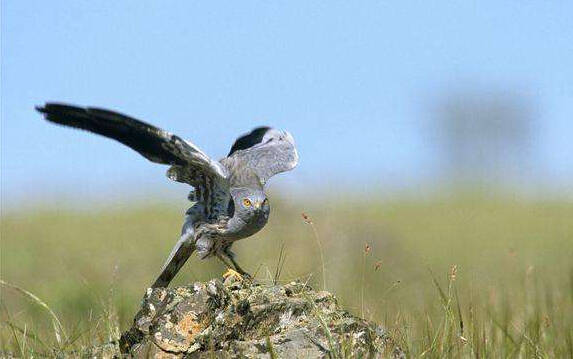Circus pygargus(Linnaeus, 1758)
IUCN
LCBasic Information
Scientific classification
- name:Circus pygargus(Linnaeus, 1758)
- Scientific Name:Circus pygargus,Montagu's Harrier
- Outline:Raptor
- Family:Falconiformes Accipitridae H.subfamily H.genus
Vital signs
- length:41-52cm
- Weight:258-380g
- lifetime:8-16years
Feature
The male has a slate blue-gray upper body, while the female has a dark brown upper body.
Distribution and Habitat
Worldwide distribution in Afghanistan, Albania, Algeria, Andorra, Armenia, Austria, Azerbaijan, Belarus, Belgium, Benin, Bosnia and Herzegovina, Botswana, Bulgaria, Burkina Faso, Burundi, Cameroon, Chad, Central African Republic, China, Democratic Republic of the Congo, Côte d'Ivoire, Croatia, Cyprus, Czech Republic, Denmark, Djibouti, Egypt, Eritrea, Estonia, Ethiopia, Finland, France, Germany, Gambia, Georgia, Ghana, Gibraltar, Guinea, Guinea-Bissau, Greece, Hungary, India, Iran, Islamic Republic, Iraq, Israel, Italy, Kazakhstan, Kenya, Jordan, Kyrgyzstan, Kuwait, Latvia, Lebanon, Lesotho, Libya, Liberia, Lithuania , Luxembourg, Liechtenstein, Macedonia, Malawi, Maldives, Mali, Malta, Mauritania, Moldova, Montenegro, Morocco, Mozambique, Nepal, Namibia, Netherlands, Niger, Nigeria, Oman, Pakistan, Palestinian Territory, occupied, Poland, Portugal, Qatar, Romania, Rwanda, Arabia, Saudi Arabia, Senegal, Serbia, Sierra Leone, Slovakia, Slovenia, Somalia, South Sudan, South Africa,
Appearance
The upper body of the male bird is slate blue-gray, the chin, throat and upper chest are dark blue-gray, the lower chest, abdomen and two flanks are white, with obvious brown vertical stripes. The anal area, lower tail coverts and leg coverts are also white or white. Light grayish white; the outer 6 primary flight feathers are black, the remaining primary flight feathers and secondary flight feathers are gray, with a black horizontal band on the upper side of the secondary flight feathers and two black horizontal bands on the lower side; the underwing feathers are white with vague red Brown vertical lines. The upper body of the female bird is dark brown, the waist is white, the skin of the lower body is yellowish white, with thicker dark reddish brown vertical stripes; the upper tail coverts are white with dark horizontal spots; the wrinkles on the neck are not obvious. The young bird is very similar to the young prairie harrier, but its feathers are darker and more brown, the wrinkles
Details
Montagu's Harrier is a bird with no subspecies.

Montagu's Harrier is a bird that often moves alone or in pairs. Most of the time during the day, it is seen lazily and leisurely gliding in the air, or flapping its wings gently over grasslands and swamps. When resting, it often roosts on trees or telephone poles.
The black-grey kite mainly feeds on rodents, frogs, lizards and large insects, and also eats small birds, chicks and bird eggs. It mainly hunts on the ground. It often flies low over the ground to patrol and hunt, and drops quickly when it finds prey. It eats large insects on the spot, and takes slightly larger prey to nearby protruding mounds to peck at.
The black-grey kite is a summer migratory bird in western Xinjiang, China, and an occasional stray bird and winter migratory bird in other areas. It migrates to its breeding grounds in early April in spring and leaves between September and October.
The breeding season of the black-gray harrier is from May to August. It usually nests in the grass on the ground near the water or in the dry reeds. The nest is mainly composed of thin shrub branches, reeds and grass, with hay inside. The size of the nest is about 50 cm in diameter. Each nest lays 3 to 6 eggs, which are white, usually without spots, and occasionally with brown spots. The size of the egg is 41.2~44.5 mm × 34~35 mm (Somov 1897). Usually one egg is laid every 24 hours, and occasionally one egg is laid every 3~4 days (Ryabov 1940). If an egg is lost, a compensatory nest is usually laid. The female bird incubates the eggs, and the incubation period is 27~30 days. The chicks are complete, and the chicks are fed by the parents after hatching until 35~42 days before they can leave the nest.
Listed in the list of China's national key protected wild animals, and is a second-level protected animal in China.
Listed in the 2012 Red List of Endangered Species of the World Conservation Union (IUCN) ver 3.1-Least Concern (LC).
Protect wild animals and eliminate game.
Maintaining ecological balance is everyone's responsibility!








